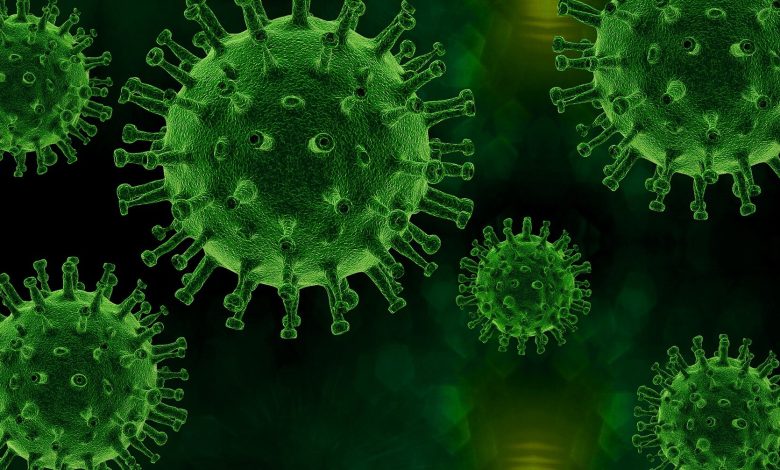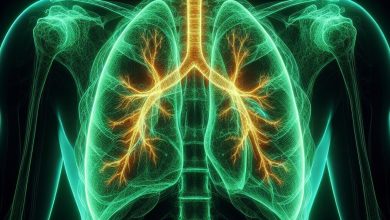
Weak spot in COVID could guide vaccine advances

After three years of infections, lockdowns, and vaccinations, we know a lot about SARS-CoV-2, the virus that causes COVID-19—but we don’t know everything. Like, why are some variants weaker than others? Why does the omicron variant spread fast, yet make people less sick? Do new virus mutations put us at fresh risk or bring us closer to the pandemic’s end? Are there more effective vaccines waiting to be developed?
A new Boston University–led study by an international team of researchers may provide some answers. In a paper published online in Nature, they identify the mutations that help omicron dodge prior immunity and show that a previously unheralded virus protein—known as NSP6—might be an essential factor in the variant’s lower disease-causing potential, or its pathogenicity.
A draft containing some of the paper’s early results had previously made international headlines in October when a series of false reports sensationally misconstrued its findings. But the study’s senior author, BU virologist Mohsan Saeed, says their research could have a major positive impact, potentially helping provide a new target for vaccines and therapeutics.
“This is an important piece of work showing that the spike protein has only minimal contribution to omicron’s lower pathogenicity—and that mutations in another protein, NSP6, play an essential role,” says Saeed, a BU Chobanian & Avedisian School of Medicine assistant professor of biochemistry. “This provides us with an exciting new concept for future vaccines and therapeutics—if we know how to weaken the virus, we can better fight it.”
The paper, which will also appear in print, was coauthored by researchers from BU and Cleveland Clinic Florida Research and Innovation Center, Loyola University, Brigham and Women’s Hospital (BWH), Harvard Medical School (HMS), University of Wisconsin–Madison, and Friedrich-Alexander-Universität Erlangen-Nürnberg and Johannes Gutenberg-Universität Mainz, both in Germany. One of the coauthors, Jonathan Li, a BWH and HMS associate professor of medicine, says that while lots of research has been concentrated on SARS-CoV-2’s spike protein, little is known about the rest of its genome.
“The non-spike portions of the viral genome have been grossly understudied. Studies like this are helping us understand which parts of the viral genome impact pathogenesis, something we still don’t know,” says Li, who points out that it’s not, for example, clear why the omicron BA.5 subvariant easily outcompeted the BA.4 version—despite the two variants sharing the same spike sequences.
“Dr. Saeed’s research is showing us the relative impact of different SARS-CoV-2 gene segments on disease severity. This type of research has the potential to not only predict which variants might lead to new waves of infection, but also identify targets for new therapeutics against COVID-19.”
Omicron’s weaknesses
Saeed’s lab has been studying SARS-CoV-2 since the beginning of the outbreak, examining the first coronavirus strain to be recovered from a patient in the United States, known as the Washington or wild-type isolate. When the omicron variant crashed onto the scene in late 2021, it soon became clear that it was spreading faster than previous variants. However, omicron was also weaker, or attenuated—less deadly. Saeed wanted to know why.
“It caused relatively less severe disease,” says Saeed. “What is so special about omicron that it inflicts milder disease? That’s how this project started—we wanted to investigate that question.”
In a secure lab in BU’s National Emerging Infectious Diseases Laboratories (NEIDL), researchers started by looking at the virus’ spike protein, a molecule that helps SARS-CoV-2 invade a cell and begin its infection—and that has also been co-opted into most vaccines. One reason for the focus on the spike is that scientists had determined it was the main differentiator between omicron and the original virus: most of the mutations were concentrated in this one protein.
“The first experiment we did was take the spike of omicron and put it into the wild-type virus,” says Saeed, who’s an investigator at the NEIDL. That created a chimeric recombinant virus—a modified virus containing genetic fragments of different viruses—they called Omi-S, a version of the original dented with an omicron protein. “The thought process here was that if spike was behind omicron’s attenuation, then the Omi-S and omicron viruses should cause a similarly mild disease.”
In some ways, he adds, nature was showing the way forward.
“Omicron causes relatively mild disease—nature is already telling us how to attenuate the virus, how the virus can become weak,” says Saeed. Making viruses weak has long been used by scientists to fight back against deadly diseases, from polio to yellow fever—Louis Pasteur was experimenting with live-attenuated vaccines using weaker versions of viruses back in the 1800s. “We can learn from nature. If we can unravel or decode nature’s path, it can help us in making vaccines.”
Gain of function, mortality rates: Explained
Unlike in Pasteur’s time, researchers today who modify any virus have to follow a very strict protocol. If they see any sign that the virus is getting stronger rather than weaker—something known as gain of function—they are required to pause their research and eradicate the virus to avoid any possibility of a more dangerous version reaching the public.
“The tradition in the field is that if you are generating a chimeric virus, you have to compare it with the backbone virus. In our case, that was the Washington isolate,” says Saeed. “Think of it this way: out of around 30 proteins, one is coming from omicron, all others from the Washington isolate.”
In this case, the chimeric virus was attenuated and stayed that way throughout the study. When the researchers compared omicron, Washington, and Omi-S in cells grown in petri dishes, says Saeed, “We found the chimeric virus was weaker compared to the wild-type virus.”
But it still wasn’t as weak as omicron, suggesting it wasn’t just the spike that was responsible for that variant’s relative lack of pathogenicity.
“We showed that spike had minimal contribution to the disease-causing ability of omicron,” says Saeed.
They also tested the three virus variants in bioengineered animal models—mice engineered to be more susceptible to disease—and saw the same patterns emerge.
The original virus killed 100 percent of infected mice, Omi-S had an 80 percent mortality rate, and all mice survived their brush with omicron. When those results were originally released by Saeed’s research team in a draft form, they sparked some confusion, with a number of largely right-wing media outlets wrongly assuming that those percentages meant the viruses had the same mortality or kill rates in humans. That was not true, says Saeed—and it’s a point he and his coauthors clarified in the final paper.
In fact, the mice used in the studies are engineered to be highly sensitive to the virus, so researchers can more quickly and effectively examine its disease-causing potential. While 100 percent of these mice die when infected with the original Washington strain of the virus, for example, the disease outcomes are massively different in humans. Less than 5 percent of patients who caught the original virus are estimated to have died as a result.
The Omi-S version of the virus was not only less lethal to the mice than the type that passed from person-to-person when COVID first struck America, it was also only so lethal to the rodents because they were bioengineered to be more prone to it.
“There’s a huge difference in disease presentation and outcome between these artificially engineered mice and human beings,” says Saeed, whose team did all of their work in biosafety cabinets in NEIDL’s Biosafety Level 3 facilities. (In order to even enter their lab, the fully vaccinated researchers have to go through a series of rooms and interlocking doors, donning multiple layers of protective gear, including an astronaut-like suit and hood.)
A lesser studied protein
Having established that the spike protein was not the sole player in diluting omicron’s potency, Saeed and the research team set out to discover what else might be the cause. They eventually landed on a different protein: nonstructural protein 6, or NSP6.
In addition to the spike protein, SARS-CoV-2 is made up of a bunch of other molecules that help it do its dirty work. At least four—including the spike—are structural proteins, which form the virus particle as it comes out of an infected cell. Another 16 are nonstructural—they help the virus replicate, creating the environment it needs in an infected cell to make copies of itself. One of those nonstructural proteins is NSP6. Its job, says Saeed, is to “contribute to the formation of certain membrane vesicles in infected cells, which serve as factories for viral genome amplification.”
When they repeated their experiments using a chimeric virus that added omicron’s NSP6 protein to Omi-S, “we observed a strong decrease in viral replication, with infection kinetics mimicking those of omicron in cell culture,” according to the paper. The Omi-S plus NSP6 virus was weaker. It also showed decreased bronchial infection in the lungs of infected mice compared to Omi-S.
“The field has been focusing for months on the impact of spike in driving omicron attenuation. This study is unique because it identifies for the first time another SARS-CoV-2 protein, NSP6, that contributes to omicron attenuation in addition to spike,” says Florian Douam, a coauthor on the study and a BU Chobanian & Avedisian School of Medicine assistant professor of microbiology. “While spike remains important in defining omicron attenuation, a lot is going on in other, more understudied, SARS-CoV-2 proteins, and this study is the first to point this out.”
Saeed says that the NSP6 protein has also been implicated in inflammation.
“When people get infected with SARS-CoV-2, there is inflammation in the lungs, leading to pneumonia and acute respiratory distress syndrome,” says Saeed. “NSP6 seems to have a role in that. I think our study will really provide impetus to study NSP6 and see what other functions it has in virus replication and the subsequent lung disease—it’s not one of the heavily studied proteins.”
Understand SARS-CoV-2, then make it less of a threat
The research team will begin digging further into NSP6 soon, but say the latest findings are exciting, because they open up a new route for taking down COVID. Understanding the small genetic differences between variants is crucial to providing new insights into how the virus causes disease, according to Douam.
“By swapping genetic characteristics between two variants with different virulence, researchers can identify key components involved in SARS-CoV-2’s disease-causing potential,” he says. “This research is critically important, not only because it tells us what the elements of the virus that regulate its virulence are, but it also highlights the potential of these virus elements to serve as great drug targets—ultimately expanding the toolbox to curve the pandemic.”
Saeed, who was recently a coauthor on a Dana-Farber Cancer Institute–led study that discovered a new receptor decoy drug that neutralizes SARS-CoV-2, says research like his can help scientists “tailor their efforts to develop antiviral drugs to a particular protein.”
Tools in pandemic control
Those outside of the scientific community who’ve been following the progress of this particular study may wonder why the final version—with a different summary, or abstract, and additional data—isn’t a straight copy, with dotted I’s and crossed T’s, of the earlier draft version that sparked worldwide attention.
The main reason: academic openness about the scientific journey. As part of Nature‘s publication process, the research team posted an early, work-in-progress look at their findings on bioRxiv, an online archive of draft—officially called preprint—biology articles. It’s used by researchers to be transparent about their work, share initial findings, and receive suggestions for improving their final papers before peer review.
It’s a bit like when an architect shows you their first plan for an addition or new kitchen; it gives you a flavor of the project, but not all the final details and refinements. A regular part of the scientific process in the modern age, publishing preprints is great for promoting open-access, but can routinely mean—just like the journey from kitchen sketch to finished design—published articles have advanced from their early drafts.
That preprint paper was written back in March 2022, and shared just one piece of the overall findings—the team’s study of the spike protein. The vital work on NSP6, which happened in part at the encouragement of peer scientists, was completed after that initial paper was written; it was added to the original material—which remains in the final paper—months later.
“In the sense of evolution, especially in the ultrafast pace of viral replication, each genomic mutation means something, and can be a hint to reveal yet another important phenomenon in infection and disease development,” says Da-Yuan Chen, a postdoctoral researcher in Saeed’s lab and the lead author on the Nature paper. “Little by little, the more we understand the virus, the more correct information we will get. Then, there will be more entry points, drugs, and strategies that we can consider as tools in disease treatment and pandemic control.”
Despite the furor sparked by the inaccurate reporting of the team’s initial findings, Saeed is hopeful that the strength of their science will outlast the false headlines.
“I think the quality of our science is more permanent,” he says. “Our discovery is important. It’s going to have an impact in the field and I think the scientific community is going to be appreciative of this work.”
Da-Yuan Chen et al, Spike and nsp6 are key determinants of SARS-CoV-2 Omicron BA.1 attenuation, Nature (2023). DOI: 10.1038/s41586-023-05697-2
Citation:
Weak spot in COVID could guide vaccine advances (2023, January 11)
retrieved 11 January 2023
from https://medicalxpress.com/news/2023-01-weak-covid-vaccine-advances.html
This document is subject to copyright. Apart from any fair dealing for the purpose of private study or research, no
part may be reproduced without the written permission. The content is provided for information purposes only.
Segue as Notícias da Comunidade PortalEnf e fica atualizado.(clica aqui)




